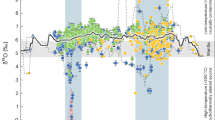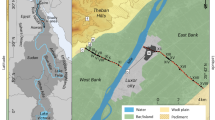Abstract
Almost all of the plutonium and americium discharged as liquid effluent from Sellafield is retained in the sediments of the north east Irish Sea1–5, whereas the waste radiocaesium shows relatively conservative behaviour in seawater and is mostly dispersed into more distant waters with only a small fraction being retained in Irish Sea sediment6–12. Sellafield discharges13,14 considered in the light of radionuclide geochemistry and radioactive decay and grow-in15 imply that, by the end of 1984, the sediments of the north-east Irish Sea contained about 6 x 102 TBq each of 239,240Pu and 241Am and of the order of 103TBq of 137Cs. This contamination, of globally significant magnitude16,17, is largely concentrated in restricted areas of fine sediment off the Cumbrian coast close to Sellafield3,4,18 so it is important to identify processes which could lead to the dispersal of these nuclides to areas of potential human contact (such as intertidal sediments) over the long time scales appropriate to the half lives of 241AM Am (458 yr), 239Pu (2.44 x 104 yr) and 240Pu (6.58 x 103 yr). Because no significant return of these actinides to solution in seawater is likely19,20, most concern must be centred upon physical dispersal processes affecting the contaminated sediment. These are ill-defined, although Hunt21 contends that actinides incorporated in intertidal sediments near Sellafield are subject to mixing with previously discharged waste and to dispersal, with removal from the surface sediments within one or two decades. Here we present the results of a study of radionuclide concentrations in surface (<0.5cm depth) intertidal sediments collected during 1984–85 which provide the basis for an estimate of the extent of northwards dispersal of the contaminated sediment and an assessment of the importance of this process relative to transport of radionuclides in solution.
This is a preview of subscription content, access via your institution
Access options
Subscribe to this journal
Receive 51 print issues and online access
$199.00 per year
only $3.90 per issue
Buy this article
- Purchase on Springer Link
- Instant access to full article PDF
Prices may be subject to local taxes which are calculated during checkout
Similar content being viewed by others
References
Hetherington, J. A. in Environmental Toxicity of Aquatic Radionuclides: Models and Mechanisms (eds Miller, M. W. & Stannard, J. N.) 82–106 (Ann Arbor Science, Ann Arbor, 1975).
Hetherington, J. A. Mar. Sci. Commun. 4, 239–274 (1978).
Smith, T. J., Parker, W. R. & Kirby, R. Institute of Oceanographic Sciences Rep. No. 110 (1980).
Pentreath, R. J., Lovett, M. B., Jefferies, D. F., Woodhead, D. S., Talbot, J. W. & Mitchell, N. T. Proc. IAEA Conf. Radioactive Waste Management 5, 315–329 (1984).
Pentreath, R. J., Harvey, B. R. & Lovett, M. B. in Speciation of Fission and Activation Products in the Environment (eds Bulman, R. A. & Cooper, J. R.) 312–325 (Elsevier, London, 1986).
Jefferies, D. F., Preston, A. & Steele, A. K. Mar. Pollut. Bull. 4, 118–122 (1973).
Livingston, H. D. & Bowen, V. T. Nature 269, 586–588 (1977).
Baxter, M. S., McKinley, I. G., MacKenzie, A. B. & Jack, W. Mar. Pollut. Bull. 10, 116–120 (1979).
McKinley, I. G., Baxter, M. S. & Jack, W. Estuarine Coastal Shelf Sci. 13, 59–67 (1981).
McKinley, I. G., Baxter, M. S., Ellett, D. J. & Jack, W. Estuarine Coastal Shelf Sci. 13, 69–82 (1981).
Livingston, H. D., Bowen, V. T. & Kupferman, S. L. J. mar. Res. 40, 253–272 (1982).
Miller, J. M., Thomas, B. W., Roberts, P. D. & Creamer, S. C. Mar. Pollut. Bull. 13, 315–319 (1982).
Cambray, R. S. AERE Harwell Rep. AERE-M-3269 (1982).
Annual Reports on Radioactive Discharges and Monitoring of the Environment 1982-84 (British Nuclear Fuels Ltd Health and Safety Directorate, Risley).
Day, J. P. & Cross, J. E. Nature 292, 43–45 (1981).
MacKenzie, A. B. & Scott, R. D. Nucl. Eng. 25, 110–122 (1984).
Holm, E. & Persson, R. B. R. Radioactivity in the Sea No. 62 (IAEA, 1977).
Hunt, G. J. Aquatic Environment Monitoring Reports Nos 3, 4, 6, 8, 9, 11, 12, 13 (Ministry of Agriculture Fisheries and Food, Lowestoft, 1979–85).
Nelson, D. M. & Lovett, M. B. Proc. IAEA Conf. Impacts of Radionuclide Releases into the Marine Environment 105–119 (IAEA, Vienna, 1981).
Sholkovitz, E. R. & Mann, D. R. Geochim. cosmochim. Acta 48, 1107–1114 (1984).
Hunt, G. J. Sci Total Environ. 46, 261–278 (1985).
MacKenzie, A. B., Baxter, M. S., McKinley, I. G., Swan, D. S. & Jack, W. J. radioanalyt. Chem. 48, 29–47 (1979).
Coleman, G. H. The Radiochemistry of Plutonium (US National Academy of Sciences Publ. NASNS 3058) (1965).
Williams, T. M. thesis, Univ. Strathclyde (1985).
MacKenzie, A. B. & Scott, R. D. Nature 299, 613–616 (1982).
Nelson, D. M. & Lovett, M. B. Nature 276, 599–601 (1978).
Cambray, R. S. & Eakens, J. D. AERE Harwell Rep. AERE-R-9807 (1980).
Cambray, R. S., Playford, K. & Lewis, G. N. J. AERE Harwell Rep. AERE-R-10485 (1982).
Author information
Authors and Affiliations
Rights and permissions
About this article
Cite this article
Mackenzie, A., Scott, R. & Williams, T. Mechanisms for northwards dispersal of Sellafield waste. Nature 329, 42–45 (1987). https://doi.org/10.1038/329042a0
Received:
Accepted:
Issue Date:
DOI: https://doi.org/10.1038/329042a0
This article is cited by
-
Evidence for the remobilisation of transuranic elements in the terrestrial environment
Environmental Geochemistry and Health (1993)
-
Sellafield waste radionuclides in Irish sea intertidal and salt marsh sediments
Environmental Geochemistry and Health (1993)
-
The determination of241Pu by liquid scintillation spectrometry using the Packard 2250CA
Journal of Radioanalytical and Nuclear Chemistry Letters (1991)
Comments
By submitting a comment you agree to abide by our Terms and Community Guidelines. If you find something abusive or that does not comply with our terms or guidelines please flag it as inappropriate.



